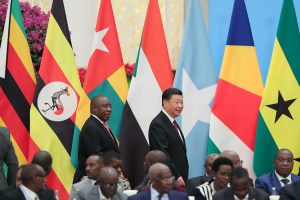
The relationship between the US and Africa hasn’t been great in recent years. Under former president Donald Trump, US-African relations suffered terribly. Trump was openly hostile to several African nations, calling some “shithole countries” and canceling US commitments to vital climate-change funds targeting Africa.
On a multi-nation visit to sub-Saharan Africa this month, US Secretary of State Antony Blinken announced a reboot in US engagement on the continent. But is it too late to re-establish flourishing ties? Perhaps.
Driving this shift is the undeniable fact that the US has lost geopolitical influence to Russia and China over the past decade. But other economic factors could transform the US-Africa relationship while dramatically improving the continent’s green energy supply.
The damage done by the Trump administration left deep scars on the psyche of several African leaders, especially in South Africa. Moreover, the Chinese and Russians have invested handsomely in the continent to fill the US leadership vacuum.
The strategy has paid off. China is one of the major funders of infrastructure projects across the continent through its Belt and Road Initiative (BRI). Beijing has also invested handsomely in Africa’s growing technology sector.
Russia’s deep links on the continent were on display in the geopolitical uproar over the Ukraine conflict. Such countries as South Africa have largely kept silent on Ukraine and refused to take sides in the conflict, which has been viewed as an implicitly pro-Russian position.
While the road to re-establishing robust relations will be difficult, there is a clear path that the US can follow, and it seems as though the leadership understands it. That path runs through South Africa’s rapidly changing energy needs.
The country, which has the most industrialized economy on the continent, is in the middle of a prolonged energy crisis. The national electric utility, Eskom, operates a fleet of aging coal-powered plants in desperate need of repairs.
Under former president Jacob Zuma, widespread corruption and government mismanagement of funds hit Eskom particularly hard, making the repairs challenging to complete. The result has been a record number of power cuts in the first half of 2022 that have crippled the South African economy in its post-pandemic recovery efforts.
President Cyril Ramaphosa recently lifted all caps on the amount of power that private renewable-energy providers were allowed to sell. Previously the government capped energy from private producers at 100 megawatts. With the caps removed, a green-energy gold rush is taking place because South Africa’s climate is perfect for wind and solar energy.
Chinese companies are leading efforts to supply solar-energy infrastructure. Yet there is a real opening for American energy companies to establish a stake in South Africa’s green revolution.
Coinciding with Blinken’s tour of the region, a group of US green-energy investors with more than $1 trillion in assets under management visited the country in a trip organized by the United States Agency for International Development (USAID) and Prosper Africa, the US government’s initiative to increase trade and investment between African nations and America.
When these companies make their first investments in the energy transition, they will follow in the footsteps of Amazon, which opened a solar farm early this year to power its growing operations in South Africa.
“There are not enough public resources in donor budgets and in local budgets, for example, in South Africa, to solve the climate crisis,” Cameron Khosrowshahi, a senior investment adviser for Prosper Africa, said in an interview with Business Tech during the visit. “There will need to be a scaling up of private capital alongside public capital to meet the challenge. And that’s part of the reason why we’re here.”
The US acknowledges that China’s approach to the continent was the best by encouraging investment in green energy projects. China established itself as a cheaper lender to fund critical infrastructure projects needed to grow African cities as the continent’s population continues to expand.
Under Trump, there was no interest in following the same road, but President Joe Biden has acknowledged Africa’s vital importance to US strategic interests and is now following China’s playbook. For this strategy to deliver results, the US must tap regional partners to aid in Africa’s shift to green energy.
Middle Eastern countries such as Israel and the United Arab Emirates have already established themselves as critical partners in Africa’s energy transformation. During the 2018 water crisis in Cape Town, for example, Emirati and Israeli companies worked with local officials on desalination projects to ease the water shortage.
Turkish companies have also been working with South African electric providers to find innovative solutions to the blackout problems (including a floating power station off the coast of Cape Town).
The US might have the capital and knowledge to invest in Africa. Still, it will need to lean on regional partners to ensure that its investments bring about a real green energy revolution on the continent.
While there is a long way to go in rebuilding relations, there has been a clear shift in approach at just the right time for Africa’s energy future.
This article was provided by Syndication Bureau, which holds copyright.

